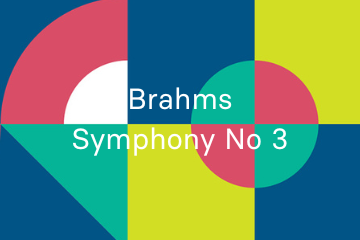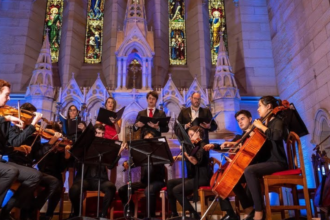Brahms Symphony No 3
The Sydney Youth Orchestra performs Brahms Third Symphony, kicking off the 2019 season for SYO conducted by Alexander Briger
PROGRAM
BRAHMS Symphony No. 3
Alexander Briger AO, Conductor
Johannes Brahms (1833-1897)
Brahms spent the summer of 1883 in the German spa town of Wiesbaden, where he produced his Third Symphony in a mere four months. It is the shortest of Brahms’ symphonies, but for this obsessively self-critical composer that was almost miraculous. Hans Richter, who conducted the first performance in Vienna, was perhaps a little over the top in calling it ‘Brahms’ Eroica’ (it was Richter, after all, who dubbed the First Symphony ‘Beethoven’s Tenth’) and yet it is a work that essays many emotional states in a highly dramatic fashion, and leads to a conclusion of great peace.
Thirty years earlier, Brahms had contributed to the ‘F-A-E Sonata’, a work jointly composed with Albert Dietrich and Robert Schumann in honour of violinist Joseph Joachim. The letters stand for Joachim’s personal motto ‘frei aber einsam’ (free but lonely) and provide a musical motif that unites the work. Brahms responded that his own motto was ‘frei aber froh’ (free but happy). The musical version of this, F-A-F, dominates the Third Symphony, which was written partly as a ‘proffered hand’ or gesture of reconciliation by Brahms, who had fallen out with Joachim over the latter’s divorce some years earlier. But the theme which the motto introduces evokes Schumann, someone dear to both Brahms’ and Joachim’s hearts.
The motto-motif provides the assertive opening gesture, where it is ‘spelled’ F-A flat-F: in F major, the A flat is chromatic, thus providing a dramatic dissonance at the work’s outset. This pattern – the first, third and eighth degrees of the scale – can be found throughout the whole work, as melodic feature at first then immediately as an accompanying figure in the bass, or seemingly inconsequential detail. But the major-minor tension pervades the work, giving it its moments of ‘heroic’ drama. The work’s dramatic unity is also effected by its overall tonal plan: the outer movements are, naturally, centred on the home key of F, while the inner movements focus on its polar opposite, C. This simple architecture is decorated at the more local level by much more surprising key relations. The F major/A flat opening is a case in point; the first subject, or thematic group, is a surging music in F major that derives from the opening theme of Robert Schumann’s Third Symphony, the ‘Rhenish’. Wiesbaden, where Brahms composed the piece, is on the Rhine; Brahms may have been unconscious of the resemblance, though the model of the First Symphony’s finale, which almost – and quite deliberately – quotes Beethoven’s autumn 2019about the musicNinth, comes to mind. But the second subject, a serene tune sounded by clarinet and bassoon, is in the distant key of A major. A short development leads to the expected recapitulation of the opening material; more important, though, is Brahms’ gradual lowering of the temperature to conclude the movement – as he does with all four in this work – softly and calmly.
The Andante takes up the pastoral sounds of clarinet and bassoon, alternating wind textures with quiet lower-string passages at first, and such textures moderate any impassioned outbursts during the course of its sonata-design unfolding. The delicate textures at the end of the movement might support Jan Swafford’s view that Brahms was not unaffected by the recent death of Wagner, ‘his rival, his respected enemy, his shadow’, whose sound-world they resemble.
The third movement is effectively a minuet, though in 3/8 not 3/4. Its main theme, characterised by gentle dissonance on the downbeats and a wave-like ebb and flow, is sung first by the cellos against a diaphanous string texture and then moves upward through the score to the winds. After a contrasting central section introduced by pulsing chords that alternate with rich string scoring, the opening material is recapitulated but in completely different instrumentation, featuring the horn and other winds. The dramatic focus of the symphony, however, is the finale where, Beethoven-style, assertive, often terse, rhythmic ideas contend with athletic, long-breathed melodies, notably one that has the classic Brahmsian tension between duplet and triplet motifs. After boisterous heroics that feature a three-beat rhythm derived from the work’s opening motto, the music reaches a state of repose where, against rippling strings, the winds build in intensity to restate the opening F-A flat-F moment, now purged of any angst.
© Gordon Kerry 2014/15Reprinted by permission of Symphony Services International
- Recorded:
- Sunday 24th March 2019
- 2.00pm
- Verbrugghen Hall, Sydney Conservatorium of Music







